The Art of Cooking Pasta
Cooking pasta may seem easy peasy, but for cooking the perfect pasta, some simple principles can go a long way.
Quantity: of course, this needs to be adjusted according to the appetite of each, but as a rule of thumb, about 100g per person should do the trick.
Digressing… In Italy, la pasta is not the main dish, but the primo, a light serving coming just after the appetizer (antipasto) and before the secondo, generally including a meat or fish, served with a side dish, the contorno.
Cooking vessel: a large and deep pot is necessary to cook pasta. The lid is only used to bring the water to the boil, never while the pasta is cooking (risk of dramatic overflow!).
Cooking water : the ratio between cooking water and pasta is very important, so that the pasta may cook without sticking to the pot or each other. The water must be boiling fully, and coarse salt added just before putting the pasta in.
You will need about 1.5L of cooking water for 100g of pasta.
Cooking time: the time recommended on the package is generally right. If you believe you will need to cook the pasta with the sauce or warm up the pasta before serving, do not hesitate to subtract 1 or 2 minutes to the recommended cooking time, so that the pasta can finish cooking with the sauce or not lose too much bite while warming up. Do not hesitate to use a timer and be precise with the cooking time.
Cooking water (the end): many recipes require keeping a little of the water in which the pasta cooked, which is salted and loaded with starch. This is the secret to adjust the sauce’s texture and facilitate the sauce adhering to the pasta. This step is crucial for the cacio e pepe pasta, typical of Rome. As a side note, the olive oil as a finishing dash, always needs to be added last, after the sauce adheres to the pasta. Otherwise, the sauce will not be able to adhere.
Keep a little cup handy to take some of this precious water before draining the pasta!

